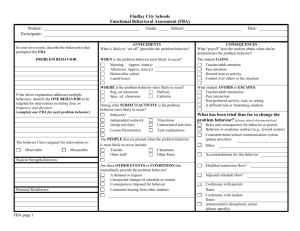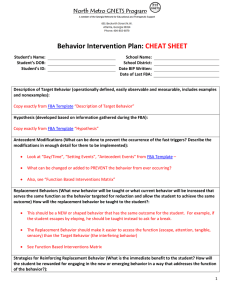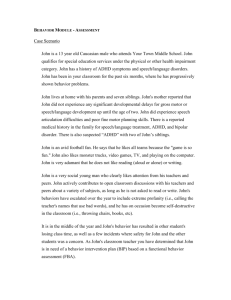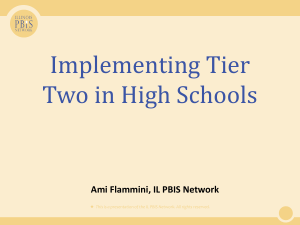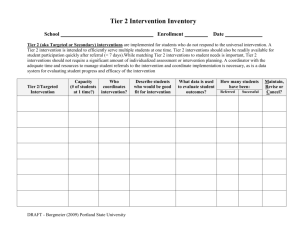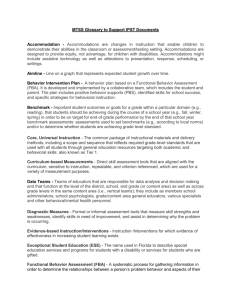Functional Behavioral from the
advertisement
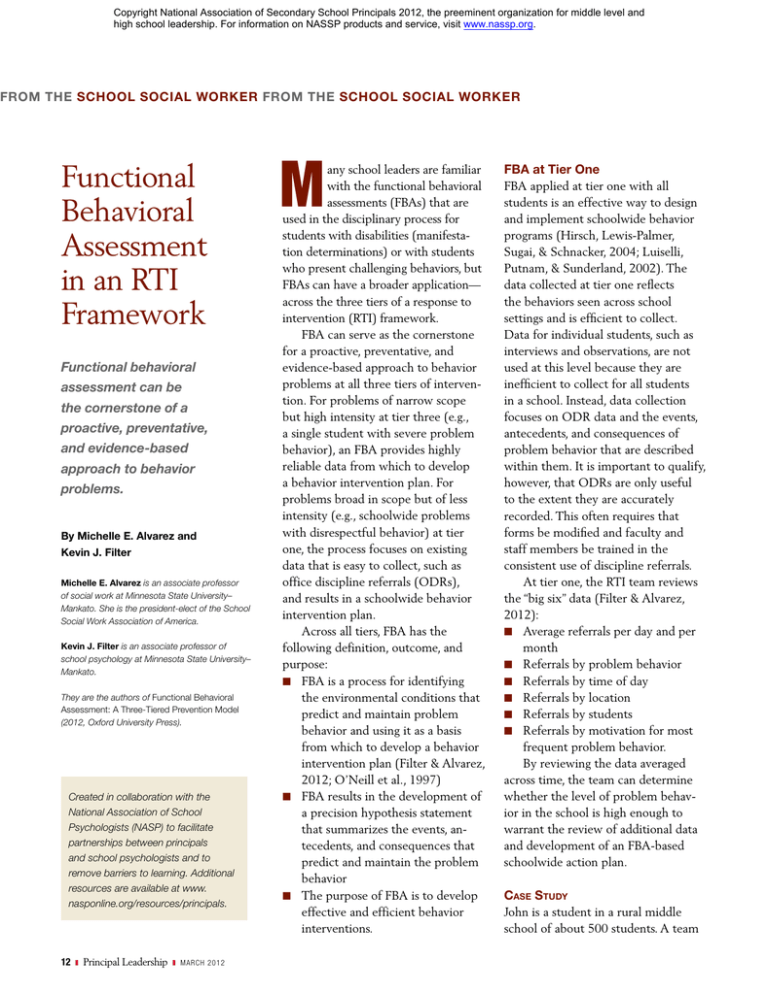
Copyright National Association of Secondary School Principals 2012, the preeminent organization for middle level and high school leadership. For information on NASSP products and service, visit www.nassp.org. from the school social worker from the school social worker Functional Behavioral Assessment in an RTI Framework Functional behavioral assessment can be the cornerstone of a proactive, preventative, and evidence-based approach to behavior problems. By Michelle E. Alvarez and Kevin J. Filter Michelle E. Alvarez is an associate professor of social work at Minnesota State University– Mankato. She is the president-elect of the School Social Work Association of America. Kevin J. Filter is an associate professor of school psychology at Minnesota State University– Mankato. They are the authors of Functional Behavioral Assessment: A Three-Tiered Prevention Model (2012, Oxford University Press). Created in collaboration with the National Association of School Psychologists (NASP) to facilitate partnerships between principals and school psychologists and to remove barriers to learning. Additional resources are available at www. nasponline.org/resources/principals. 12 z Principal Leadership z m arch 2012 M any school leaders are familiar with the functional behavioral assessments (FBAs) that are used in the disciplinary process for students with disabilities (manifestation determinations) or with students who present challenging behaviors, but FBAs can have a broader application— across the three tiers of a response to intervention (RTI) framework. FBA can serve as the cornerstone for a proactive, preventative, and evidence-based approach to behavior problems at all three tiers of intervention. For problems of narrow scope but high intensity at tier three (e.g., a single student with severe problem behavior), an FBA provides highly reliable data from which to develop a behavior intervention plan. For problems broad in scope but of less intensity (e.g., schoolwide problems with disrespectful behavior) at tier one, the process focuses on existing data that is easy to collect, such as office discipline re­ferrals (ODRs), and results in a s­ choolwide behavior intervention plan. Across all tiers, FBA has the following definition, outcome, and purpose: n FBA is a process for identifying the environmental conditions that predict and maintain problem behavior and using it as a basis from which to develop a behavior intervention plan (Filter & Alvarez, 2012; O’Neill et al., 1997) n FBA results in the development of a precision hypothesis statement that summarizes the events, antecedents, and consequences that predict and maintain the problem behavior n The purpose of FBA is to develop effective and efficient behavior interventions. FBA at Tier One FBA applied at tier one with all students is an effective way to design and implement schoolwide behavior programs (Hirsch, Lewis-Palmer, Sugai, & Schnacker, 2004; Luiselli, Putnam, & Sunderland, 2002). The data collected at tier one reflects the behaviors seen across school settings and is efficient to collect. Data for individual students, such as interviews and observations, are not used at this level because they are inefficient to collect for all students in a school. Instead, data collection focuses on ODR data and the events, antecedents, and consequences of problem behavior that are described within them. It is important to qualify, however, that ODRs are only useful to the extent they are accurately recorded. This often requires that forms be modified and faculty and staff members be trained in the consistent use of discipline referrals. At tier one, the RTI team reviews the “big six” data (Filter & Alvarez, 2012): n Average referrals per day and per month n Referrals by problem behavior n Referrals by time of day n Referrals by location n Referrals by students n Referrals by motivation for most frequent problem behavior. By reviewing the data averaged across time, the team can determine whether the level of problem behavior in the school is high enough to warrant the review of additional data and development of an FBA-based schoolwide action plan. Case Study John is a student in a rural middle school of about 500 students. A team in the school, led by the school social worker, is responsible for all three tiers of the FBA process and reviews schoolwide data three times each academic year. It is fall, and the team is reviewing the data from the previous academic year to evaluate the progress made with previous schoolwide interventions. Team members begin by summarizing ODR data. They note a decrease in disrespectful behavior in classrooms over the past year, which was the target of their previous intervention. But the overall levels of problem behavior indicate that they still had more office referrals than the national average. They then review the rest of the data and determine that disruptive behavior in the classroom has been a growing problem. Using the big six data, they create the following hypothesis: “Disruptive behavior is occurring at an increasing frequency in the classroom during the first few minutes of each class period and numerous students have been involved. The behavior appears to be motivated by obtaining peer attention.” The team then develops a schoolwide action plan to address the problem. Because the problem behavior has been occurring at the beginning of class, the team decides to work with all teachers to review transition protocols and review best practices for getting students engaged quickly. The team also recommends that teachers use “social time” at the end of class as a reward for whole-class good behavior during the class period, thereby using the activity that maintained disruptive behavior to instead reward good behavior. FBA at Tier Two Tier two focuses on identifying the students who display at-risk behavior and providing targeted supports that address the current antecedents and consequences of a problem behavior. The goal of a tier two FBA is not to develop an individualized intensive intervention, but to provide efficient small group supports for students who are at risk. The data collection process begins with the review of ODRs to determine the most problematic behavior and its antecedents (e.g., time of day, location, others involved) and consequences (e.g., administrative decision, perceived motivation). A review of the student records and short interviews with one or more staff members who are familiar with the students’ behavior in school are conducted. The process concludes with a review of the findings, which the team uses to create a hypothesis. Interventions at this level are generally evidence-based small group interventions rather than individualized interventions. The task of the team is to determine which evidence-based intervention currently available in the school best matches the function of each student’s behavior. If none are available, the team must identify a new program. After students are matched to interventions, the team will monitor fidelity of implementation and effectiveness. If the intervention is ineffective even after minor modifications, a more intensive process for the student is warranted. The goal of a tier two FBA is not to develop an individualized intensive intervention, but to provide efficient small group supports for students who are at risk. Case Study The team noted that four students, including John, had been referred for disrespectful behavior two to four times and were in need of more support than could be offered at march 2012 z Principal Leadership z 13 from the school social worker from the school social worker Action Steps n Ensure accurate recording of office discipline referrals. n Consult with the school social worker and the school psychologist about the process of applying FBA to general education and whole-school issues. n Organize and participate in teams that manage FBAs and behavior interventions in the schools. n Work with staff members to update office discipline referrals to include functional information about antecedents and consequences. n Use software, such as School- wide Intervention Systems (SWIS), to track office discipline referrals and facilitate easy data collection and analysis. n Facilitate the training of all staff members in the consistent use of office discipline referrals to ensure an efficient and valid data source for tier one FBAs. the schoolwide level. The team then began the tier two FBA process with John and the other three students. The team reviewed the existing ODRs and school record data. They also conducted brief interviews with the students’ teachers to determine what antecedents, contexts, and consequences were related to their problem behaviors. Students were matched to existing evidence-based interventions. John’s brief interviews and ODRs indicated that his bullying and fighting behaviors were due to his desire for peer attention. The tier two interventions were effective in improving the behaviors, the interventions were eliminated, and John was monitored for continued improved behavior. FBA at Tier Three An FBA is conducted at tier three to address severe and persistent problem behaviors. FBAs at this level of intensity identify students who have either failed to respond to less intense interventions or display dangerous behavior that requires immediate attention. The process at this level involves interviews from multiple sources and direct observations (Crone & Horner, 2003). An intensive individualized b ­ ehavior intervention plan is developed on the basis of the results of the FBA (Crone & Horner, 2003). Although this type of FBA is often conducted with students in the context of a special education evaluation, this process can be useful when planning interventions for individual students even if they do not qualify for special education services. School psychologists, school social workers, and special education teachers are often familiar with the tier three FBA process for individual students. To make this work within an RTI framework, however, those staff members will need to be part of an FBA team that supports all students. The team’s decisions must be based not only on the data collected in tier three but also on the data collected throughout the RTI process. School social workers and school psychologists can: n Work with teams to collect FBA data. n Work with teams to develop behavior interventions that are based on FBA results. n Consult with the teachers and staff members who are responsible for implementing behavior interventions to ensure fidelity of implementation. n Provide training in consistent use of office discipline referrals to ensure an efficient and valid data source for tier one FBAs. n Work with a team to select and implement evidence-based interventions that can be matched to behavior functions in tier two. 14 z Principal Leadership z m arch 2012 from the school social worker from the school social worker Summary FBA is relevant to supporting the behavior of all students in a school as a process for determining the environmental conditions that predict and maintain problem behavior so that effective and efficient interventions can be developed. When used at the tier one level within an RTI framework, the FBA process can be used with data from all students, or it can be used with a few select students who display severe problems at tier three of an RTI framework. The differences at each tier relate to the intensity of the process and the specific sources that data are collected from, but the process of connecting assessment to intervention is consis- 16 z Principal Leadership z m arch 2012 tent. FBA can serve as the cornerstone for a proactive, preventative, and evidence-based approach to behavior problems at all three tiers of intervention that allows schools to address behaviors from their first appearance to their chronic presence. PL References n Crone, D. A., & Horner, R. H. (2003). Building positive behavior support systems in schools: Functional behavioral assessment. New York, NY: Guilford Press. n Filter, K. J., & Alvarez, M. E. (2012). Functional behavioral assessment: A threetiered prevention model. New York, NY: Oxford University Press. n Hirsch, E. J., Lewis-Palmer, T., Sugai, G., & Schnacker, L. (2004). Using school bus discipline referral data in decision making: Two case studies. Preventing School Failure, 48(4), 4–9. n Luiselli, J. K., Putnam, R. F., & Sunderland, M. (2002). Longitudinal evaluation of behavior support intervention in a public middle school. Journal of Positive Behavior Interventions, 4(3), 182–188. n O’Neill, R. E., Horner, R. H., Albin, R. W., Sprague, J. R., Storey, K., & Newton, J. S. (1997). Functional assessment and program development for problem behavior: A practical handbook (2nd ed.). Pacific Grove, CA: Brooks Cole Publishing. Authors’ note: Forms and links to resources for three-tiered FBAs are available at www.mnsu.edu/ psych/psyd/people/filter/book/documents.

